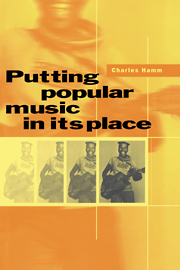Book contents
- Frontmatter
- Contents
- Acknowledgements
- Preface
- 1 Modernist narratives and popular music
- 2 Rock and the facts of life
- 3 Changing patterns in society and music: the US since World War II
- 4 “If I Were a Voice”: or, The Hutchinson Family and popular song as political and social protest
- 5 Some thoughts on the measurement of popularity in music
- 6 Elvis, a review
- 7 Home cooking and American soul in black South African popular music
- 8 Rock ‘n’ roll in a very strange society
- 9 African-American music, South Africa, and apartheid
- 10 “The constant companion of man”: Separate Development, Radio Bantu, and music
- 11 Privileging the moment of reception: music and radio in South Africa
- 12 Music and radio in the People's Republic of China
- 13 Towards a new reading of Gershwin
- 14 A blues for the ages
- 15 Graceland revisited
- 16 Dvořák in America: nationalism, racism, and national race
- 17 The last minstrel show?
- 18 The Role of Rock, a review
- 19 Genre, performance, and ideology in the early songs of Irving Berlin
- 20 Epilogue: John Cage revisited
- Index
5 - Some thoughts on the measurement of popularity in music
Published online by Cambridge University Press: 05 February 2012
- Frontmatter
- Contents
- Acknowledgements
- Preface
- 1 Modernist narratives and popular music
- 2 Rock and the facts of life
- 3 Changing patterns in society and music: the US since World War II
- 4 “If I Were a Voice”: or, The Hutchinson Family and popular song as political and social protest
- 5 Some thoughts on the measurement of popularity in music
- 6 Elvis, a review
- 7 Home cooking and American soul in black South African popular music
- 8 Rock ‘n’ roll in a very strange society
- 9 African-American music, South Africa, and apartheid
- 10 “The constant companion of man”: Separate Development, Radio Bantu, and music
- 11 Privileging the moment of reception: music and radio in South Africa
- 12 Music and radio in the People's Republic of China
- 13 Towards a new reading of Gershwin
- 14 A blues for the ages
- 15 Graceland revisited
- 16 Dvořák in America: nationalism, racism, and national race
- 17 The last minstrel show?
- 18 The Role of Rock, a review
- 19 Genre, performance, and ideology in the early songs of Irving Berlin
- 20 Epilogue: John Cage revisited
- Index
Summary
In the 1970s most writers on popular music, scattered through a number of different disciplines or outside academia altogether, worked in isolation from one another, in touch only through their published work. The only journal devoted to popular music was the Journal of Research in Popular Music, narrowly focused on sociology.
This isolation began to break down in the last years of the decade. Several panels during a conference of The International Musicological Society held in Berkeley (California) in August of 1977 brought together a handful of musicologists studying popular music. Growing British interest in the music of North America, particularly at the universities of York and Keele, prompted several conferences on popular music that led to the first International Conference on Popular Music Research in June of 1981, for which several hundred people from many (mostly European) countries gathered in Amsterdam.
My paper for this conference could have been subtitled “One week in May.” The organizers had suggested that media dissemination might be taken as one defining characteristic of popular music; so it occurred to me to watch every television show aired in the United States for the week of 17–23 May 1981 that featured considerable amounts of music, and then to assemble statistics on the size of the audience for each.
The experience was critical for my subsequent work, if not for the future of popular music study in general.
- Type
- Chapter
- Information
- Putting Popular Music in its Place , pp. 116 - 130Publisher: Cambridge University PressPrint publication year: 1995
- 2
- Cited by

